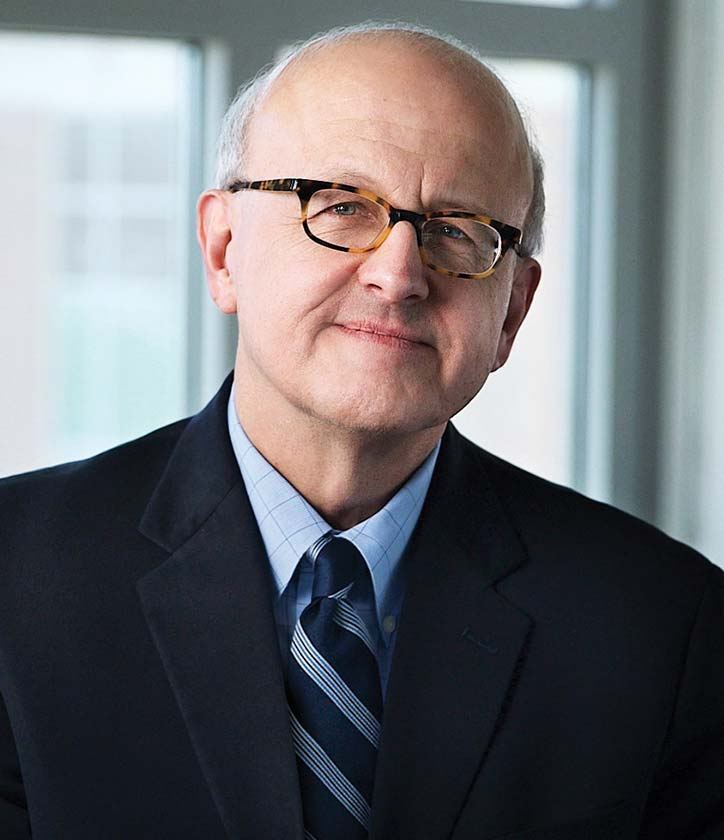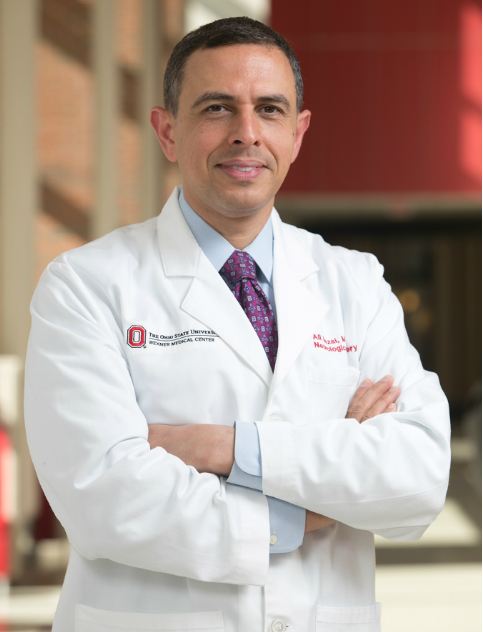
A view from above of Ohio State’s sprawling medical campus. Since January 2017 at least nine high-ranking employees have left Ohio State’s Wexner Medical Center — five of whom signed a letter that was critical of the culture between the medical center and James Cancer Hospital. Credit: Jack Westerheide | Photo Editor
Since January 2017, at least 10 high-ranking employees — from department chairs to business leaders — have left Ohio State’s Wexner Medical Center for jobs elsewhere, five of whom were among those that signed letters in May criticizing the medical center’s culture under then-CEO Sheldon Retchin’s leadership.
One of the latest signees to announce a departure is John Campo, who, along with his wife Rhonda Campo, will be leaving in March to join West Virginia University’s medical enterprise. Currently, John Campo is the medical center’s director of psychiatry and behavioral health and Rhonda Campo is the associate executive director of business development. Both will have heightened roles in West Virginia.
In an interview with The Lantern, John Campo said the decision to move on from Ohio State wasn’t taken lightly by anyone who has left, but added that he believed the university did not adequately address the concerns expressed in the letters.
“I think that the university missed an opportunity to hear what I think were very sincere concerns by the folks who wrote those letters,” Campo said. “We were reaching out to [University] President [Michael] Drake and the leadership to say we’re concerned that we’re losing our way.
“I think more listening and less concern about the public-relations impact of the letters probably would have been prudent.”
Those who signed the letters in May, and left or plan to leave the medical center, include: Ali Rezai, Theodoros Teknos, Randy Nelson, Amy Johnson and John Campo.

John Campo is the director of psychiatry and behavioral health at Ohio State’s Wexner Medical Center. Credit: Courtesy of Ohio State
Those who did not sign the letters, but left or plan to leave include: Richard Goldberg (who left in January 2017, before the letters were released), Michael Caligiuri, Courtney DeVries, Rhonda Campo, and Jeff Walker.
“We wish them all the best,” university spokesman Chris Davey said in response to a request for Ohio State to comment on the nine departures.
Rezai, Nelson, DeVries and John Campo all worked within Ohio State’s Neurological Institute and have or will have roles within WVU’s Rockefeller Neurological Institute.
The Campos are the fifth and sixth medical center employees since January 2017 to accept new roles at West Virginia.
Former Ohio State University President E. Gordon Gee was hired to the same role at WVU in 2013. His first marquee hire was in 2015, bringing Clay Marsh from Ohio State to lead the university’s academic medical center. Since then, doctors and executives have followed.
Rezai joined the ranks in September to lead the WVU Rockefeller Neurological Institute, something that John Campo said drew the couple to the school — specifically its leaders Gee, Marsh and Rezai recognizing Rhonda’s skill sets.
However, John Campo said Gee isn’t the prevailing driver in bringing Ohio State’s talent, himself included, to Morgantown. It was the culture.
“There is something I think going on there in terms of the culture and how they are trying to drive success at an academic health center. That, I found compelling,” John Campo said. “Doesn’t mean they are right, it means it was something appealing to me. That was a hook.”
Despite his departure, Campo praised Ohio State, calling it a “very good medical center and an exceptionally good medical school.” He said the decision to leave Ohio State, a place he loves, left him emotional.
He said that Craig Kent, dean of the College of Medicine, whose management was criticized in the letters, “is working very hard and seems earnest in his efforts to address the concerns expressed by faculty.”

Rhonda Campo is the associate director of business development at the Wexner Medical Center and will be leaving next month. Credit: Courtesy of Ohio State
“He had only been here a relatively short time when the letters came out, so the issues brought up in the letters largely preceded him. I really do wish him well and want OSUWMC to be nothing less than great,” Campo said.
However, one thing Campo said Ohio State lacks is a completely fused relationship between medical center and on-campus mental-health facilities.
“…That’s one unfortunate thing here at Ohio State is that you have the medical center over here and then you have student health and student mental health over on the university sides,” Campo said. “And it’s not like we don’t collaborate. There are some wonderful people there and we like working with them, but we’re separate services.”
Partnership is something that Marsh, now WVU’s vice president of health sciences and former Wexner Medical Center COO, said drives its medical center’s success.
“We have focused on building a culture of openness, safety, creativity and collaboration at WVU and across our state that continues to attract top talent from many institutions who want to be a part of an exciting new adventure,” Marsh said in an emailed statement.
Culture and collaboration is a clear concern for many who have left Ohio State, with the letters signed in May detailing an “Us versus Them” divide between the James Cancer Hospital and Wexner Medical Center.
Retchin is still employed at Ohio State as a senior adviser to Drake.
In November, Drake said Ohio State is searching for a chancellor to lead its entire medical enterprise, a position that will have the same wide-ranging responsibilities Retchin held.
Some of the tension, and possibly reason for departures, surrounds the relationship between the medical center and independent cancer center, which Caligiuri led before his abrupt departure.
In the span of a month, Caligiuri, who when first stepping down as director announced he would stay on as a faculty member, left the medical center after more than 20 years at Ohio State to take a leadership role at City of Hope in California.
In an interview with The Cancer Letter following his departure, Caligiuri was critical of the power dynamic at Ohio State and said he was “freed from some of the constraints and bureaucracy that exist within most matrix cancer centers.”
Another departee for WVU, Nelson, is now the chair of its neurological research at the School of Medicine. He was chair of the Department of Neuroscience and the director of basic science at Ohio State’s Neuroscience Research Institute, which he established.
Nelson, one of the pre-eminent researchers on the impact of looking at digital screens before going to sleep, has published more than 400 research articles and 11 books. Additionally, he is an editor of “Hormones and Behavior Journal of Experimental Zoology” and contributed to HuffPo.

Ali Rezai left Ohio State for West Virginia in September to lead the Rockefeller Neurological Institute. Courtesy of Ohio State
DeVries left Ohio State in January to become WVU’s chair of oncology research at the cancer institute. She was a former neuroscience professor and mentor faculty at the Institute for Behavioral Medicine Research and her work characterized the effects of social isolation on health outcomes ranging from stroke to cancer.
Johnson, a letter signee, is a researcher whose work focuses on cancer prevention and diagnosis. She left Ohio State — and academia — in September after 16 years at the university to become the senior scientific director at Janssen Research and Development, a pharmaceutical company owned by Johnson & Johnson.
Teknos, also a letter signee, left in August to become the president of University Hospitals Seidman Cancer Center in Cleveland. A well-known researcher on head and neck cancers, Teknos had been chair of Ohio State’s nationally ranked Department of Otolaryngology.
Walker’s departure, reported by The Lantern Thursday, is the most recent. Currently the COO of The James, Walker plans to join Caliguiri at City of Hope its senior vice president of transformation development.
The Wexner Medical Center is one of the university’s biggest drivers in revenue, topping $3 billion for the first time in 2016 and making up 48 percent of the university’s total budget that same year.
Ohio State is developing a plan to increase faculty engagement in the medical center, according to November medical center Board of Trustees documents.
At the January Board meetings, Ohio State’s Vice President of Human Resources Susan Basso said the university is crafting a plan to attract and retain top faculty.
“The narrative has been: ‘The problem has been within the medical center,’ but there are always problems to fix,” Campo said. “But there are issues bigger than just the medical center that probably relate to the relationship between the university and the medical center that deserve a look and some consideration.
“I think that the issue here is about culture, that the whole culture thing is one I don’t know is limited to the medical center or if it’s larger here.”
Editor’s note, 11:15 a.m. Feb. 8: This article was updated include the news of Jeff Walker’s departure.


